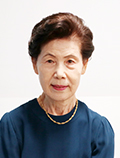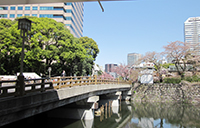HOME>麹町出張所地区連合町会>紀尾井町>町会のご紹介
Kioicho Town Association
The Presidents of Kioicho Town Association

Mrs. Michiyo Toda
3rd Generation: |
Mrs. Michiyo Toda | (2022 to Present) |
| Second Generation: | Mr. Toyoshige Toda | (1994 to Present) |
| First President: | Mr. Akira Fukuda | (from 1978 to 1994) |
The History of the Town Association
1 The naming of the town and neighborhood
Kioicho was the residential area of the Shogunate families, namely, the residence of the Kii domain and Owari domain, as well as, an extra residence for the II family of the Hikone domain that existed from the early Edo period of the 1620’s. The whole area was given over to housing samurai families.
After the Meiji restoration of December 1871 the designation for the samurai residences was no longer needed, and the area became, Kioicho, a part of Kojimachi ward. In May of 1910 the town was named “Kioicho” by taking one syllable from each family name, that is, Ki of Kii, O of Owari, and I of II.
With the re-zoning that took place in July 1934, Kioicho was divided into Kojimachi 5 chome and 6 chome and the town has developed as it is to the present.
In January of 1980, with the enforcement of the new Japanese addressing system, the name of our town “Kioicho”, which represents our heritage, was preserved due to the efforts of our town association’s first president, Mr. Akira Fukuda.
2 Kioizaka

Kioizaka refers to the road extending from Kuichigai mitsuke ato to Shimizudani Park. The Shinsen Tokyo Meisho Zukai includes information of the historical backrounds of various Tokyo sights. Kioizaka is a slope going down from Kuichigai to Shimizudani Park direction and its name also represents a triangular positioning of the Kii family, Owari family, and Ii family properties of that time. It was also called Shimizuzaka because the slope ended with Shimizudani at the bottom.
On the morning of May 14, 1878, the samurai statesman of Satsuma, Okubo Toshimichi, one of the three important leaders of the Meiji Restoration, was en route to the Akasaka Imperial Palace from Ura Kasumigaseki in his horse carriage. As he was about to pass the stone bridge at the bottom of Kioizaka he was accosted and stabbed to death by Ichiro Shimada and six other samurai from Ishikawa Prefecture. This assassination is referred to as the “Kioizaka no Hen.” Shimada took such an action to right the injustice and despotism of domain dominated government, which he believed was promoted by Okubo. They immediately surrendered themselves to the Imperial Household Department and in July were sentenced to life imprisonment.
3 Shimizudani Park
The residence of the Meiji statesman Okubo Toshimichi was located at Shimizudani Park in the first year of the Meiji period. On May 14, 1878, on his way to attend the royal award ceremony to receive a medal in recognition for his efforts in battles of the Seinan War, he was assassinated by Ichiro Shimada and six others. Okubo was 49 years of age when he was killed. After his death he was awarded the distinguished service honoree title of “Udaijin seinii. His burial took place in Aoyama Cemetery with a national funeral.
The property of his residence was donated to the Tokyo Government and a park was built. In the central section of the park a statue of Toshimichi Okubo was erected in tribute to his great services.
The founders planted double flowered cherry blossoms along the facade of the statue. It is the oldest park in Chiyoda ward.
4 Sophia University
Sophia University was founded in 1913 and is the first Catholic University in Japan. At the behest of Pope Pius X the Society of Jesus sent three Jesuit missionaries in 1908 to prepare for the opening of a Catholic University in Japan. Additional members were sent including Fr. Hoffman who later became the first president of Sophia. In 1911 the legal person Jochi Gakuin was established and about 14000 square meters of land were purchased in Kioicho for a total of 430000 yen. At the time of opening in 1913 Sophia university welcomed 15 students.
The name Sophia means the highest form of wisdom. The words are taken from a section of the Litaniae Lauretanae, “Sedes Sapientiae”
We can trace the root and spirit of Sophia back to the missions and deeds of Saint Francis Xavier, a Jesuit missionary, who in 1549, first brought Christianity to Japan. Possessing a Master of Arts degree from the University of Paris, he was greatly attracted by the depth of Japanese intellectual curiosity and high standards. It became Xavier’s dream to establish a university in Japan similar to the University of Paris which would serve as a place for cultural, philosophical, and religious exchange. 360 years later his dream came true with the establishment of Sophia University.
5 Saint Ignatius Church
Before the war the Kojimachi Catholic Church was established in 1936 in
At the time the church was called Saint Theresa of the Infant Jesus. The church was burnt down in the Great Tokyo Air Raid of 1945. Within the grounds of Sophia University the Jesuit community chapel, located in the Kulturheim, served temporarily as Kojimachi Church.
After the war in April of 1949 on the Kojimachi side of Yotsuya mitsuke Onaimon-nai Saint Ignatius Church was built. This church with its classical bell tower was long the symbol of Kojimachi. However, the wooden structure showed the wear and tear of 50 years time. In 1998 a new oval shaped Saint Ignatius Church was built and this included a bell tower as well.
6 Benkei Bashi Bridge
At first, a Kyoto Style wooden bridge Benkeibashi was built at the outer moat of Akasakamitsuke in 1888. The name Benkeibashi was named after another bridge across the Aizome River near the Otamaike pond in Kanda, (Kanda Matsued-cho, currently Iwamoto-cho). Due to reclamation work on the river the old bridge was dismantled and what materials remained were reused in the building of the new Benkeibashi bridge. The original ”Benkeibashi” was built by the master carpenter “Daiku Benkei Kozaemon,” who was in the service of the Edo Shogunate. The name of the bridge comes from that man’s name.

The bridge was fully reconstructed in 1985 and careful consideration was given to its setting and historical nature. The construction began in October 1983 and was completed in December 1985. The opening ceremony was held on December 18, 1985 with many guests related to the construction in attendance.
